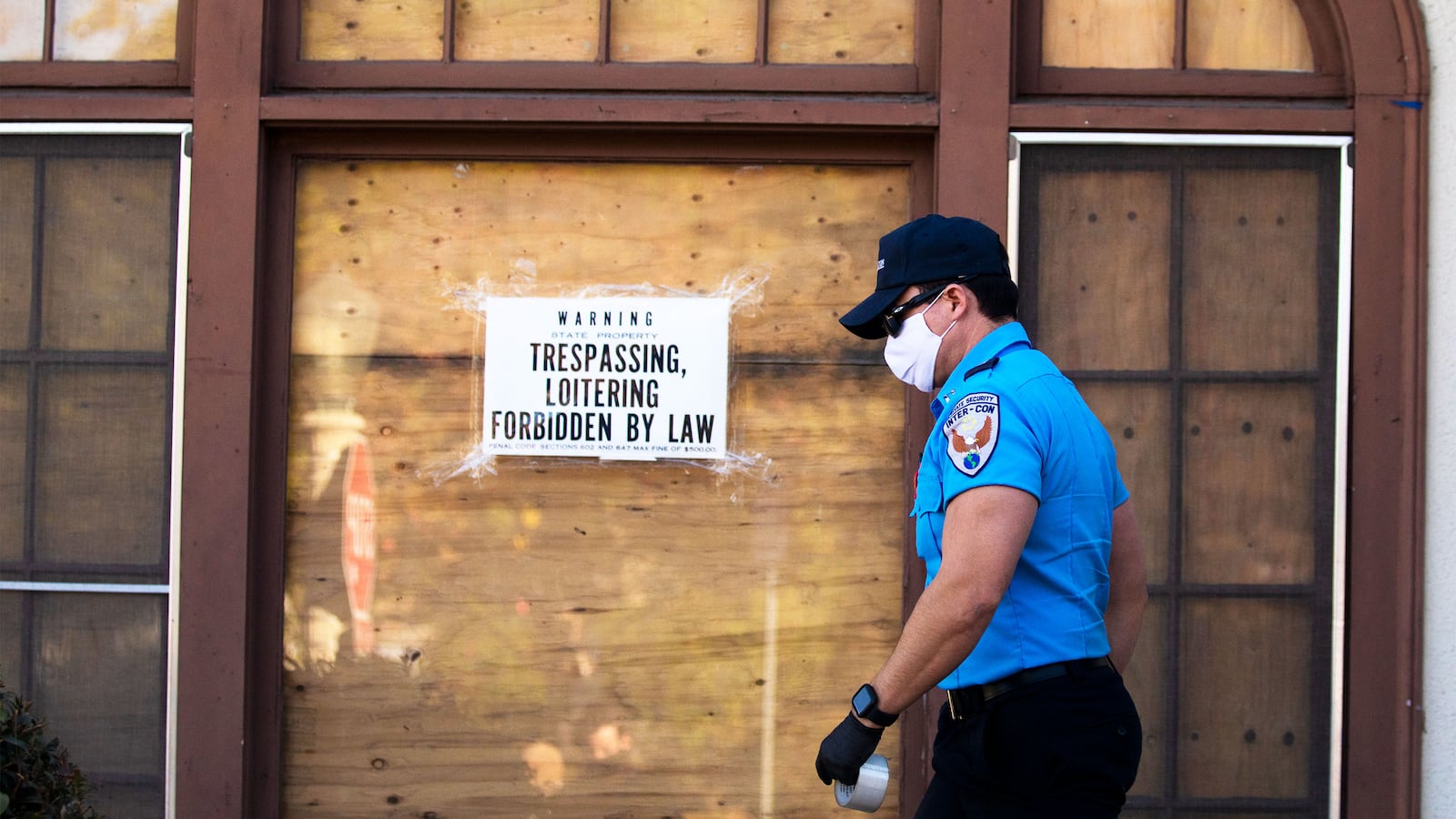PASADENA, California–Everything people love to hate about California and the rich progressives who control it can be found on a quiet, tree-lined cul-de-sac in an affluent neighborhood here.
Homelessness. Sclerotic bureaucracy. Racial injustice disguised as public progress. Skyrocketing real-estate prices. Bulldozing history so miles of asphalt can be poured.
Those issues are embodied on West Palmetto Drive by a long-vacant home, its blue exterior and lawn both bleached out by the sun, acquired for a notorious freeway that was never built.
At least until very recently, it was guarded at all hours by the California Highway Patrol (CHP) so the unhoused didn’t illegally enter and squat.
“It’s like a work program for the Highway Patrol,” said John Kvammen, renter of a state-owned home here, adding that his neighborhood had looked like “a police state.”
It wasn’t the first time the Highway Patrol had a mission like this one. In November, officers moved on squatters in the L.A. neighborhood of El Sereno, after housing activists had already won control of some vacant homes there thanks to an occupation begun in March. The state’s transportation agency, Caltrans, clearly doesn’t want the same saga to play out in Pasadena.
State Route 710 was originally supposed to connect Pasadena with the docks of Long Beach, and all but 4.5 miles were built. But that gap remains after one of America’s longest-running freeway fights ended in late 2018, with Caltrans admitting defeat.
What should have happened next, advocates say, is simple. Caltrans should have sold the Palmetto home, along with 150-plus other empty houses located in Pasadena, South Pasadena, and El Sereno. (In total, Caltrans owns 443 residential and non-residential properties in the SR710 corridor.)
While making these dwellings available for habitation wouldn’t solve the region’s homeless problem—not with more than 66,000 unhoused people in Los Angeles County, according to a 2020 report—it might be a step in the right direction.
Instead, Caltrans, at no small expense, hired CHP to protect its properties across the three cities 24/7, starting around Thanksgiving, for a stretch of more than seven weeks.
“Vacant homes along the State Route 710 that were broken into are unsafe and uninhabitable for occupants,” Caltrans spokeswoman Lauren Wonder told The Daily Beast. “As such, Caltrans requested the CHP remove trespassers so that the properties can be re-secured and boarded up.”
One patrolman said the deterrence detail, at any given moment, was 60-units strong, and that didn’t include the private security firms with which Caltrans previously contracted. He and another patrolman said they came to the assignment from their homes in the San Diego area, a drive that’s two hours one-way—and on the clock.
CHP refused to say how many units were committed, citing operational security, but said public safety was not affected because officers who were regularly scheduled to patrol were not used for this detail—only officers on days off or outside of their regular shift.
“The CHP is responsible for the safety and security of all state properties,” spokeswoman Jaime Coffee told The Daily Beast before the officers appeared to almost entirely vacate the area on Jan. 15. “As such, we are assisting Caltrans with ensuring these state-owned properties remain secure.”
Caltrans declined to give a cost, saying the agency has yet to receive CHP’s invoice. And neither the Highway Patrol nor Caltrans explained why the patrolling seemed to halt when it did, although CHP cruisers still are seen occasionally driving by in support of a private security firm. (Caltrans claims the same number of security personnel remains.)
But the Highway Patrol’s surge amounted to a show of force on peaceful streets that had residents decrying waste of state resources—especially during a horrific pandemic.
“Couldn’t they just build a park for now?” asked a Palmetto Drive homeowner holding her children who asked not to be identified for fear of professional repercussions. She was referring to the Caltrans-owned vacant lots at the cul-de-sac’s end; beyond those is the 710’s final southbound exit in Pasadena, which dumps upwards of 8,800 vehicles daily onto city streets.
How Pasadena ended up with Ponch and Jon parked in front of empty homes is a story that began in the years following World War II, when Southern California embraced both booming growth and the automobile, leading to sprawl and a network of freeways.
Throughout the lengthy 710 saga, there has been a common theme, according to Democratic state Assemblymember Chris Holden, whose district encompasses Pasadena.
“At the heart of it is displacement,” he told The Daily Beast.
It was in the early 1960s when Caltrans started buying properties near Old Town Pasadena to make room for the northern end of 710 extension and its connections to State Route 134 and Interstate 210.
Razed, Holden said, were single-family homes mostly owned by Black and Japanese Americans, with those of a few whites and Chinese Americans adding to the diversity.
“It impacted the continuity of community,” Holden said.
He added that the only remaining sign of the once-vibrant African-American neighborhood there was historic Friendship Baptist Church, where the Rev. Martin Luther King Jr. preached on two occasions to congregants, including, in 1965, a young Holden and his family.
For Caltrans to plow under a neighborhood comprised of people of color, yet move cautiously when approaching majority-white populations, was simply how the agency operated, critics say. As researcher Jovanni Perez noted in the paper “The Los Angeles Freeway and the History of Community Displacement,” only 61 percent of freeways planned during the 1940s were constructed, but all the freeways running through Hispanic-dominated East Los Angeles were built—such as the 710 as it approached El Sereno from the south.
Then came a cruel twist: Despite the devastation wreaked upon that community, work on the 710 stopped in the 1970s, never to resume. Ever since, Pasadena has had to put up with a 52-acre scar (locally known as the Stub or Ditch) adjacent to its shopping district and underneath famed Colorado Boulevard.
Although legal action halted Caltrans, the agency still acted like the 710 extension was an inevitability. The route was altered a few times, and when that happened, Caltrans acquired new properties while hanging on to those now out of harm’s way. Some homes were rented out, and tenants found themselves at the mercy of what they described as an impassive, uncaring bureaucracy in Sacramento.
“They’ve been an awful landlord,” Holden flatly stated.
Said Kvammen, who has lived in his house since 1973, was unsparing. “Caltrans has never taken care of these properties, just like they’ve never cared at all about the vacant homes,” he told The Daily Beast.
A renter-turned-advocate in El Sereno wasn’t mincing words either.
“Evil, at times. They’ve made our lives miserable,” said Roberto Flores, who helps lead advocacy group United Caltrans Tenants (UCT). “Seven years ago, they decided to raise our rent 10 percent every six months.”
Caltrans currently owns 460 residential/multi-residential units, but the occupancy rate is less than three-quarters, with 327 active rental accounts.
Auctioning off the homes would seem to be the obvious solution. If the properties were put on the open market, there’s no doubt they would bring a windfall to Caltrans. Consider the home on Palmetto Drive: Although the real-estate site Zillow doesn’t provide a value for that house, the one next door is listed at a cool $2.5 million.
Of course, for many renters, not to mention the homeless, such a price would be out of reach. That’s why state law gives existing Caltrans renters priority at buying their homes and, if those tenants are income-qualified, a break on the purchase price.
Still, even that has been tangled in the courts. UCT sued the state after Caltrans put inflation adjustments on original acquisition prices and presented them as “affordable.”
“At the inflated price,” Flores said, “the house would be at about 400 percent of affordable tenant income.”
Wonder, the Caltrans spokesperson, said the agency was pursuing regulatory changes needed to expedite sales—and doing what it could to help renters.
“As Caltrans moves to sell the remaining homes on the corridor,” Wonder said, “it is committed to working with local entities and other stakeholders to ensure the properties are used for affordable housing.”
“Caltrans also works with tenants who need additional time to pay delinquent rent,” she added.
Holden wants to see a chain of events that leaves all satisfied: Caltrans sells vacant lots to the cities for affordable housing, the current renters move into that housing, and then Caltrans puts all its vacant homes up for sale at market prices.
But with nothing moving quickly, homeless advocates can’t wait. That’s why in March, a dozen El Sereno homes were occupied—“reclaimed”—by families, forcing the issue until Caltrans agreed to lease the properties to the Housing Authority of the City of Los Angeles.
In the days before Thanksgiving, reclaimers tried again in El Sereno. This time, Caltrans was less than accommodating.
More than 60 arrests ensued, CHP said, and according to the advocacy group Reclaim and Rebuild Our Community, the reclaimers remain in limbo because trespassing and burglary charges have yet to be filed or dropped.
One reclaimer rousted from a home was Sasha Atkins, a 31-year-old stylist with a 9-year-old son. When the Highway Patrol moved in, she fled out the back and was sheltered by a neighbor, she said.
Atkins recalls looking at the numbers of officers deployed and thinking, “Shouldn’t they be out patrolling?”








